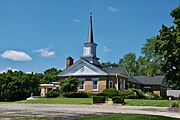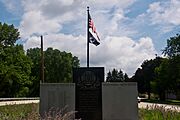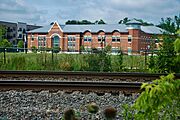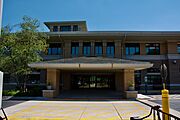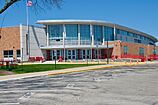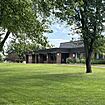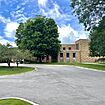Mundelein, Illinois facts for kids
Quick facts for kids
Mundelein, Illinois
|
|||
|---|---|---|---|
|
Village
|
|||
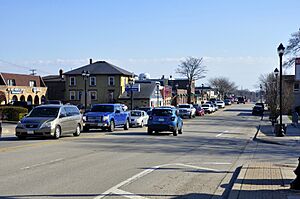
Downtown Mundelein in March 2024
|
|||
|
|||
| Motto(s):
"Start here. Star here"
|
|||
| Country | |||
| State | Illinois | ||
| County | Lake | ||
| Township | Fremont, Libertyville | ||
| Incorporated | February 1, 1909 | ||
| Government | |||
| • Type | Village | ||
| Area | |||
| • Total | 10.12 sq mi (25.88 km2) | ||
| • Land | 9.718 sq mi (24.83 km2) | ||
| • Water | 0.405 sq mi (1.05 km2) 4.2% | ||
| Elevation | 742 ft (226 m) | ||
| Population
(2020)
|
|||
| • Total | 31,560 | ||
| • Density | 3,291.96/sq mi (1,271.09/km2) | ||
| Standard of living | |||
| • Per capita income ,538 | Median household income ,027 | ||
| ZIP code(s) |
60060
|
||
| Area code(s) | 847 and 224 | ||
| FIPS code | 17-51349 | ||
Mundelein is a village in Lake County, Illinois, United States and a northern suburb of Chicago. Per the 2020 census, the population was 31,560, making this the fourth largest town in Lake County. The village straddles Libertyville Township and Fremont Township, and borders Grayslake, Ivanhoe, Diamond Lake, and Libertyville. The village lies 33 miles northwest of the Chicago Loop.
Mundelein was first settled by European settlers in 1835, and was incorporated in 1909 after a spur line connected the village to the Chicago North Shore and Milwaukee Railroad. The University of Saint Mary of the Lake opened in 1921, and in June 1926 the village hosted the closing events of the 28th International Eucharistic Congress, bringing hundreds of thousands of people to the town. Four name changes happened throughout the village's history, including two after incorporation.
Contents
History
The community now known as Mundelein has been inhabited since at least 1650, when the Potawatomi people were known to have been trading with French fur traders. The first European inhabitants reached the area in the early 19th century. Peter Shaddle (for whom a street is named) was the first known settler, building a log cabin in the area now owned by St. Mary of the Lake Seminary in 1835.
The next settlers were tradesmen escaping from England's industrial depression, who became farmers in the Mundelein area. In honor of their former professions, they named the city "Mechanics Grove", and built schools, churches, and businesses. The community grew and (while still unincorporated) changed its name to "Holcomb", in honor of John Holcomb, a person who was active in the area's development. As Holcomb, the community added a railway station and a post office. The Holcomb area incorporated in February 1909 under a new name, "Rockefeller", a reference to businessman John D. Rockefeller.
The name Rockefeller was short lived, however. In July 1909, the community became "Area". This name change was requested by a local educational entrepreneur named Arthur Sheldon, who bought 600 acres (2.4 km2) near town and built a school on it. The school taught sales techniques, including the philosophy of "AREA", which stood for "Ability, Reliability, Endurance, and Action." At one time, it boasted 10,000 students, many of them women (which was unusual for 1909).
In 1915, Archbishop George Mundelein (later Cardinal) of Chicago purchased the property from Sheldon after the Area campus closed to re-establish the Archdiocese's University of Saint Mary of the Lake, also known as the Mundelein Seminary, which continues to exist today.
On December 10, 1924, the Village Board held a special meeting with representatives from the Soo Line Railroad, who requested that the board change the village's name to Mundelein (for the cardinal). The board voted to make the change and asked the Illinois Secretary of State to make the name change. They received permission in April 1925, and the Village Board passed an ordinance changing the village's name to Mundelein. Cardinal Mundelein donated the village its first new fire truck, a 1925 Stoughton. The fire truck was officially turned over to the village at a ceremony held at the St. Mary of the Lake Seminary on July 17, 1925. The original Village Hall, built in 1929 with a few additions over the years, was used until June 2014.
Geography
Mundelein is located at 42°15'47.0"N 88°00'14.4"W (42.263049, -88.004010).
According to the 2010 census, Mundelein has a total area of 9.969 square miles (25.82 km2), of which 9.57 square miles (24.79 km2) (or 96%) is land and 0.399 square miles (1.03 km2) (or 4%) is water.
Demographics
| Historical population | |||
|---|---|---|---|
| Census | Pop. | %± | |
| 1910 | 358 | — | |
| 1920 | 420 | 17.3% | |
| 1930 | 1,011 | 140.7% | |
| 1940 | 1,328 | 31.4% | |
| 1950 | 3,189 | 140.1% | |
| 1960 | 10,526 | 230.1% | |
| 1970 | 16,128 | 53.2% | |
| 1980 | 17,053 | 5.7% | |
| 1990 | 21,215 | 24.4% | |
| 2000 | 30,935 | 45.8% | |
| 2010 | 31,064 | 0.4% | |
| 2020 | 31,560 | 1.6% | |
| U.S. Decennial Census 2010 2020 |
|||
2020 census
| Race / Ethnicity | Pop 2010 | Pop 2020 | % 2010 | % 2020 |
|---|---|---|---|---|
| White alone (NH) | 18,123 | 16,431 | 58.34% | 52.06% |
| Black or African American alone (NH) | 416 | 601 | 1.34% | 1.90% |
| Native American or Alaska Native alone (NH) | 28 | 21 | 0.09% | 0.07% |
| Asian alone (NH) | 2,719 | 3,492 | 8.75% | 11.06% |
| Pacific Islander alone (NH) | 6 | 7 | 0.02% | 0.02% |
| Some Other Race alone (NH) | 38 | 80 | 0.12% | 0.25% |
| Mixed Race/Multi-Racial (NH) | 390 | 836 | 1.26% | 2.65% |
| Hispanic or Latino (any race) | 9,344 | 10,092 | 30.08% | 31.98% |
| Total | 31,064 | 31,560 | 100.00% | 100.00% |
Note: the US Census treats Hispanic/Latino as an ethnic category. This table excludes Latinos from the racial categories and assigns them to a separate category. Hispanics/Latinos can be of any race.
Income
The median income for a household in the village was $69,651, and the median income for a family was $75,083. By 2017, median incomes were estimated at $86,336 per household and $96,813 per family. Males had a median income of $50,290 versus $34,087 for females. The per capita income for the village was $26,280. About 3.0% of families and 4.6% of the population were below the poverty line, including 5.2% of those under age 18 and 3.4% of those age 65 or over.
Places
Mundelein Heritage Museum
Mundelein Heritage Museum is a museum owned by the Mundelein Historical Commission. The museum opened in 1983 in a train facility, which been intended for the Soo Line Railroad in the 1920s. The Historical Society of Fort Hill Country, founded in 1983, previously ran the museum as the Fort Hill Museum, until the society disbanded in 2018 due to low membership. The museum was closed from 2018 to 2020, as operations of the museum were transferred to the Mundelein Historical Commission.
Memorial Point
Memorial Point is a triangle-shaped war memorial located at the intersection of Hawley Street and Illinois Route 176. The monument was built in 1969 and contains an artillery anti-tank gun, a flagpole, and an engraved granite monument listing residents of the town who died in war. Plans were made in 2015 to relocate the memorial to Kracklauer Park in the south of the town but were abandoned after public backlash.
Community Protestant Church
The Community Protestant Church in Mundelein first opened in 1889 with 16 members. The initial building for the church was built on the junction of Illinois Route 176 and U.S. Route 45 in 1896. The church moved to its current position in 1949 and was nicknamed "the church on the hill" due to its location. The building was renovated from 1957 to 1958 to build an education wing, including a library and a nursery. The church hosted an annual Christmas dance in the 1940s.
Fremont Public Library
Fremont Public Library was established on Park Street and Lake Street in the village in 1955, before later being moved to a larger site on Midlothian Road in 2001. The old site, which was previously used as a barbershop, was sold to Mundelein Elementary School District 75 where it has been used as an administration building. The property was considered for a sale in 2018.
Village Hall
The current village hall was completed and opened in 2014. The building is a 10-acre, 32,000-foot building located next to the Metra station in the center of the town, and cost over $10 million to build.
The original village hall, which was built and dedicated in 1929, cost the village $36,000 to construct. The building, which was described as "Tudor-style" and "Alpine-style", was also previously used as a fire station, municipal jail, and a community center. The building was demolished in 2019 for commercial development.
Model Farm
Model Farm was a prototype farm used to demonstrate new farming technology in the 1920s. The property included a six-room farmhouse and an exhibit hall. The 80-acre farm was opened in 1928 by the Public Service Company of Northern Illinois, which was a company run by businessman Samuel Insull. The property was sold to a cattle breeder in 1940 and was partially used as the site for the construction of Mundelein High School.
Events
Mundelein hosts an annual four-day event called the Mundelein Community Days for recreation around Independence Day. Events have included carnivals, live music, parades, and beauty pageants.
An outdoor music festival titled "Miracle in Mundelein" was held on September 9, 2023. ..... The festival featured hip hop, reggae, and EDM, and featured the rock band Joe Russo's Almost Dead. .....
Races
Annually on Independence Day, a 5K run called the Freedom Classic 5K is held. The race was first held in 1979.
Mundelein hosts an annual amateur and professional bike race called the Mundelein Grand Prix. The race is part of the Intelligentsia Cup Chicago series. The race was first held in 2021.
Economy
- Top employers
According to Mundelein's 2022 comprehensive annual financial report, the top employers in the village are:
-
2022 # Employer Type of Business # of Employees % Village Pop. 1 Medline Industries Hospital supplies 639 2.02% 2 Ruprecht Company Meat processing 552 1.75% 3 University of Saint Mary of the Lake Seminary / School for the priesthood 295 0.93% 4 Amcor Flexibles Healthcare, Inc. Flexible polyethylene packaging 290 0.92% 5 Maclean-Fogg Co. Industrial fasteners (plants and offices) 288 0.91% 6 Mundelein High School #120 Public high school 270 0.86% 7 Mundelein Elementary School #75 Public elementary school 239 0.76% 8 Village of Mundelein Village government 194 0.61% 9 Pet Factory 175 0.55% 10 Con-Way Freight 92 0.29% Total 3,034
Education
The first school in Mundelein was called Mechanics Grove School and opened in 1837. The school was located on the roads that would become Maple Avenue and Route 176. Mundelein is currently served by five elementary school districts.
Public schools
For the history see Arthur Zilversmit, Changing schools: Progressive education theory and practice, 1930-1960 (University of Chicago Press, 1993).
Diamond Lake School District 76
Diamond Lake School District was established in 1847. The district includes three schools: Diamond Lake school from kindergarten through second grade, West Oak Elementary Schools from third to fifth grade, and West Oak Middle School from grades six to eight. Fairhaven School was previously a part of the district, and is now a special education school.
Fremont School District 79
Fremont School District 79 (previously Fremont Center District 79) includes Fremont Elementary School, Fremont Intermediate School, and Fremont Middle School. The District annexed Ivanhoe School District 77, Swan School District 78, Maple Grove School District 80, and Murray School District 81 in 1955.
Hawthorn Community Consolidated School District 73
Hawthorn Community Consolidated School District 73 primarily serves the nearby village of Vernon Hills. The school district contains four elementary schools, two middle schools, and a bilingual school.
Libertyville School District 70
Libertyville's school district was founded c. 1850. The school district includes four elementary schools: Adler Park School, Butterfield School, Copeland Manor School, Rockland School, and one middle school (Highland Middle School).
Mundelein Elementary School District 75
Mundelein School District was founded with the establishment of Lincoln School in 1894. The school district comprises Washington Early Learning Center from Kindergarten to second grade, which opened in 1951, Mechanics Grove Elementary School from third to fifth grade, which opened in 1970, and Carl Sandburg Middle School from sixth through eighth grade, which is named after American writer Carl Sandburg who dedicated the building in 1959.
The district's boundary changed significantly in 2003–2004, in response to studies indicating sharp disparities in ethnic makeup among various schools in the district.
Mundelein High School
The public high school for Mundelein is Mundelein High School. It was built in 1960 and started classes in 1961 and split its own school district in 1964. The campus was renovated in 1987, 1997, and 2016.
Private Schools
University of Saint Mary of the Lake
University of Saint Mary of the Lake is a seminary in Mundelein. The seminary was designed by architect Joseph W. McCarthy. The charter for the school was initially granted in 1844, and the first version of the school was opened in Chicago. The seminary closed in 1866 due to financial problems, and the building was destroyed in 1871 in the Great Chicago Fire. The Archdiocese of Chicago started purchasing land in Mundelein in 1915, and the school opened in 1921. The seminary is the third largest employer in the village,. The village namesake, George Mundelein, is buried in the Chapel of the Immaculate Conception on campus.
Carmel High School
Carmel High School is a private Catholic high school in Mundelein. The site of the school was formerly occupied by a railroad terminal for the 28th International Eucharistic Congress. Carmel High School for boys opened in 1962, and the sister school Carmel High School for girls opened in 1963. The schools merged in 1988.
Santa Maria del Popolo School
Santa Maria del Popolo School previously served as a private Catholic school. The four-room school opened in 1950 with 187 enrolled students. The Roman Catholic Archdiocese of Chicago announced the closure of the school in January 2014, which by then only enrolled approximately 80 students. The school was previously a K–8 school, and later, an elementary school.
Transportation
Public transportation
Mundelein has a station on Metra's North Central Service, which provides weekday rail service between Antioch and Chicago Union Station. The station opened in 1996 after a thirty-three-year hiatus after commuter rail service was shut down in 1963. The tracks that the North Central Service ran on were bought out by CN in 2001 after the railway acquired Wisconsin Central Ltd.
Pace provides bus services on Route 574 connecting Mundelein to Grayslake, Vernon Hills, and other destinations.
The town is near Milwaukee Mitchell International Airport, O'Hare International Airport, and Midway International Airport.
Major streets
Interstate 94 is located five miles east of Mundelein.
Media
The Chicago Tribune provides coverage for Mundelein, and runs the local newspaper Mundelein Review through its ownership of Pioneer Press. Mundelein is also provided news coverage by Daily Herald, based in Arlington Heights, Illinois, and FOX 32 Chicago.
Notable people
- Cardinal George Mundelein, the namesake of the town, died of coronary thrombosis in his Mundelein residence in 1939
Sports
- Zaire Barnes, American football linebacker for the New York Jets
- Ryan Borucki, professional baseball pitcher
- Charlie Campbell, soccer player
- Courtney Frerichs, track and field athlete and Olympic medalist
- Johnny McCarthy, professional baseball first baseman
- Sean McGrath, American football tight end and coach
- Brienne Minor, American tennis player
- Bud O'Rourke, professional basketball forward
- Andy Sabados, American football guard
Works citied
- Killackey, Shawn P (2009). Mundelein. Arcadia Publishing. ISBN 9780738577326.
See also
 In Spanish: Mundelein (Illinois) para niños
In Spanish: Mundelein (Illinois) para niños




